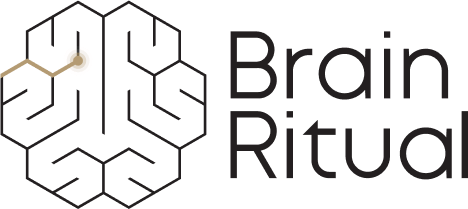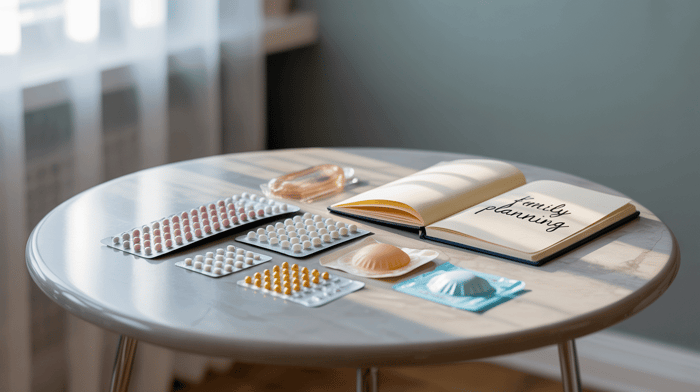At a glance -
|
That crushing migraine pain that arrives just before your period starts isn't just bad timing, it's your hormones sending your brain into crisis mode.
The connection between migraine and hormones is undeniable and backed by science.
About 70% of all migraine sufferers are women, and many report their worst attacks coinciding perfectly with hormonal shifts. This isn't coincidence, it's biology.
This report notes that migraine is a predominantly female disorder, with a 1-year prevalence nearly threefold higher in women (17%) compared to men (6%), implying women constitute a significant majority of sufferers (approximately 70% when considering prevalence ratios).
What many migraine sufferers don't realize is that the dramatic hormonal fluctuations throughout your cycle can either protect your brain or trigger neurological chaos.

And when it comes to support, the wrong hormone therapy can actually make you significantly worse.
But with the right HRT approach? Many women report lowering their migraine frequency by 50-76%.
The key is understanding exactly how estrogen and progesterone affect your migraine brain, and which hormone formulations actually help instead of harm.
How Your Hormones Might Be Behind Your Migraine
Understanding exactly how your hormones trigger requires looking beneath the surface at the complex biochemical dance happening in your body throughout your cycle.
While the connection between hormones and headaches might seem obvious, the specific mechanisms reveal why some women are more vulnerable than others, and why certain phases of your cycle consistently bring pain.
What dropping estrogen does to your brain
When your estrogen levels suddenly drop, like right before your period starts, your brain feels it immediately.
Estrogen isn't just a reproductive hormone; it's actually a powerful brain protector that helps regulate pain signals and blood vessels.
Here's what happens: Estrogen normally helps keep inflammation down and stabilizes the excitability of your brain cells.
It also maintains healthy serotonin levels, that feel-good neurotransmitter that also regulates pain.
When estrogen plummets, these protective effects disappear almost overnight.
Your blood vessels respond dramatically to this change.
They dilate and constrict, and for migraine-prone brains, this vascular chaos combined with neuroinflammation creates the perfect storm for a migraine attack.
It's like removing the guardrails that were keeping your brain's pain response in check.
Many women report their worst in the 2-3 days before their period starts, exactly when estrogen takes its sharpest dive.
This isn't coincidence; it's your brain chemistry responding to hormone withdrawal.
How low progesterone adds to the problem
While estrogen gets most of the attention, progesterone isn't innocent in this hormonal migraine equation.
When progesterone levels drop (which happens alongside estrogen before your period), it creates another layer of vulnerability in your brain.
The table below will make it easier to quickly grasp how progesterone deficiency contributes to migraine vulnerability through multiple mechanisms.
Effect of Low Progesterone | How It Impacts Migraine |
Minimized GABA Activity | • Removes progesterone's natural calming effects on the central nervous system |
Altered Fluid Balance | • Causes fluid retention and bloating |
Hormone Ratio Imbalance | • The estrogen-to-progesterone ratio becomes as important as absolute levels |
This imbalance is why simply addressing estrogen isn't always enough.
Many women find that they persist even when taking estrogen-only HRT.
The delicate dance between these two hormones requires careful balancing.
Why hormone ups and downs make things worse
If there's one thing the migraine brain hates, it's change, and hormonal fluctuations represent some of the most dramatic chemical changes your body experiences regularly.
The migraine brain is hypersensitive to environmental changes of all kinds, from weather shifts to stress levels.
But hormone fluctuations create internal environment changes that are particularly potent.
Research shows it's not necessarily low hormone levels that trigger, but rather the rapid drops and shifts between high and low states.
This is why many women find they are most frequent and severe during perimenopause, that transitional phase before menopause when hormones can swing wildly from day to day with no predictable pattern.
Your brain essentially gets caught in a constant state of adjusting to these hormonal shifts.
Even normal monthly cycles can create this problem if you're predisposed to.
Your hypothalamus, the brain's hormone command center, detects these changes and can trigger a cascade of neurological events that culminate in migraine pain.
Interestingly, many women find pregnancy brings welcome aid from, especially in the second and third trimesters.
This is because hormone levels remain consistently high during this time without the drops that typically trigger attacks.
What HRT Combo Should You Know About?
Not all hormone replacement therapy (HRT) is created equal when it comes to migraine management.
With the right combination and delivery methods, HRT can be a game-changer for migraine control, but the wrong approach can make your headaches significantly worse.
The ideal approach combines transdermal bioidentical estrogen (patches or gels) with natural progesterone, creating hormonal stability.
As mentioned at the start of this article, for perimenopausal women, this well-designed HRT can lower migraine frequency by 50-76%.
HRT Component | Best Options for Migraine Sufferers | Why It Works | What to Avoid |
Estrogen Delivery Method | Patches or gels (transdermal) | • Provides steady hormone levels without peaks and valleys | • Non-bioidentical solutions |
Progesterone Type | Natural/bioidentical progesterone (Prometrium, micronized progesterone) | • Minimizes inflammation in the central nervous system | • Synthetic progestins (medroxyprogesterone, norethindrone) |
Dosing Schedule | Continuous (without breaks) | • Eliminates withdrawal headaches | • Hormone-free weeks |
Benefits of Steady Hormone Levels | • Stabilized blood vessels | • Minimizes the abnormal vasodilation/constriction cycle in | • Hormone fluctuations increase migraine vulnerability |
Many doctors now recommend "continuous" hormone therapy protocols without hormone-free intervals for migraine patients.
Some find that wearing an estrogen patch even during their period week suppresses the estrogen drop that triggers their worst headaches, while others benefit from slightly increasing their dose during vulnerable times.
While no hormone approach eliminates all, creating hormonal stability offers significant help for many women who've struggled with cyclical headache patterns.
What to Avoid So Your HRT Doesn't Backfire
Even the most carefully designed hormone therapy can trigger if it contains problematic ingredients or delivery methods.
Knowing what to avoid is just as important as knowing what to seek out.
The hidden risks of synthetic hormones
Synthetic hormones differ structurally from the hormones your body naturally produces, and these differences can spell trouble for migraine sufferers.
Synthetic progestins (like medroxyprogesterone acetate/Provera, norethindrone, or levonorgestrel) are particularly problematic.
They don't bind to brain receptors the same way that natural progesterone does, and many synthetic versions actually trigger inflammatory responses in sensitive individuals.
These synthetic versions:
Lack the calming, GABA-enhancing effects of natural progesterone
Can increase nitric oxide production, which dilates cerebral blood vessels, a key step in migraine pathophysiology
Don't provide the same neuroprotective benefits as bioidentical progesterone
Often cause fluid retention that can increase intracranial pressure
Similarly, synthetic estrogens like ethinyl estradiol (commonly found in birth control pills) can be more likely to trigger than bioidentical estradiol.
They persist longer in the body and have stronger effects on clotting factors and inflammation markers.
Many women report that switching from synthetic hormones to bioidentical versions significantly lowers their migraine frequency, even when keeping the same dosing schedule.
This isn't surprising given the different ways these hormones interact with brain chemistry.
Why pills can trigger more headaches
The oral route of hormone administration is particularly problematic for migraine sufferers for several reasons:
Oral hormones must pass through your digestive system and liver before reaching your bloodstream (that "first-pass metabolism" we mentioned earlier). This not only minimizes the amount of hormone that reaches your circulation but also transforms estrogen into metabolites that can promote inflammation and affect blood vessels.
Pills create a daily hormone peak and trough pattern. Your levels surge shortly after taking the pill, then gradually decline until your next dose. For the migraine-sensitive brain that craves stability, this daily roller coaster can serve as a regular trigger.
Oral estrogen increases production of clotting factors and inflammatory proteins as it's processed by your liver. Women with migraine with aura are already at slightly higher risk for stroke, making this additional clotting risk particularly concerning.
If you must take hormones orally (some women prefer oral progesterone for its sleep benefits), taking your dose at the same time each day and considering extended-release formulations can help minimize the fluctuations.

However, for estrogen specifically, transdermal delivery remains vastly superior for migraine support.
Which products you should avoid completely
Beyond the general categories of synthetic hormones and oral delivery methods, certain specific hormone products are particularly risky for migraine sufferers:
Combination birth control pills, especially those with higher estrogen doses or newer generation progestins
Triphasic birth control pills that deliberately create hormone fluctuations throughout the month
Hormone-releasing IUDs containing levonorgestrel can trigger in some women (though others do fine with them)
Pellet implants that release unpredictable amounts of hormone over time, creating peaks and valleys
Premarin and other conjugated equine estrogens, which contain multiple estrogen types not identical to human estrogens
Continuous combined HRT products that blend estrogen and synthetic progestins in the same pill or patch
While compounded hormones can be valuable when prepared by reputable pharmacies, inconsistent potency can create exactly the kind of hormone fluctuations that trigger.
Finally, be wary of adrenal supplements or "natural" hormone boosters that claim to balance hormones.
Many contain phytoestrogens or adaptogens that can unpredictably affect hormone levels, potentially triggering headaches in sensitive individuals.
The safest approach for migraine sufferers tends to be pharmaceutical-grade, FDA-approved bioidentical hormones with established quality control standards, delivered in the most stable method possible.
Working with a healthcare provider who specializes in both hormone management and headache disorders can help you navigate these complex choices while minimizing migraine risk.
How Age and Menopause Change Your Migraine Patterns
While hormones affect throughout your life, the relationship becomes particularly complex during perimenopause and menopause.
Understanding these age-related changes can help you anticipate and manage your migraine patterns better.

Why migraine often spikes in your 40s
Many women are caught off guard by a sudden worsening of migraine in their 40s, even if they've had their headache patterns well-controlled for years.
This perimenopausal migraine surge happens for several important reasons:
Perimenopause creates the perfect hormonal storm for migraine sufferers.
Your ovaries begin producing hormones more erratically, leading to unpredictable fluctuations.
One month might bring estrogen levels higher than you've had since your 20s, while the next month might see dramatic drops that trigger severe migraine attacks.
These hormonal roller coasters often start years before your periods become noticeably irregular.
In fact, it can be one of the earliest signs of perimenopause, appearing even when your cycles still seem normal.
The erratic nature of perimenopausal hormone changes is particularly problematic.
Your brain has spent decades adapting to a relatively predictable hormonal rhythm, and suddenly that predictability disappears.
This creates a state of neurological vulnerability where even minor hormone shifts can trigger significant.
Adding to the challenge, perimenopause often coincides with other life factors that impact:
Peak career and family responsibilities increasing stress levels
Changes in sleep quality (also hormone-related)
Weight fluctuations that can affect hormone metabolism
Other midlife health changes like thyroid issues or insulin resistance
This combination of factors explains why the 40s can be the most challenging decade for many women with hormones.
Without proper management, some women experience almost daily headaches during this transitional time.
How the right HRT can help before and after menopause
Strategically designed hormone therapy can be transformative during both perimenopause and postmenopause, but the approaches differ slightly for each phase.
During perimenopause, the primary goal is stabilization. Low-dose continuous transdermal estrogen can help smooth out the erratic hormone fluctuations that trigger.
Rather than trying to boost your overall hormone levels (which are often already fluctuating between high and low), the focus is on suppressing the sharp drops that typically precede migraine attacks.
Some clinicians use a "cycle stabilization" approach during perimenopause:
A consistent baseline of transdermal estradiol
Slightly higher doses during vulnerable times in your cycle
Natural progesterone timed to provide maximum neurological benefit
Careful monitoring and adjustment as your natural hormone production changes
After menopause (typically defined as 12 months without a period), your ovaries produce very little estrogen, creating a more stable but much lower hormone environment.
For many women, this hormonal stability actually improves, which is why some experience welcome support after completing the menopausal transition.
However, other women find that the loss of estrogen's neuroprotective effects worsens their headaches or changes their pattern. In these cases, low-dose HRT can help by:
Providing enough estrogen to support healthy brain function
Maintaining consistent levels without fluctuations
Supporting overall neurological health as you age
The key difference in postmenopausal HRT is that your natural hormone production no longer creates a cycling background that your supplemental hormones need to accommodate.
This often allows for simpler, more straightforward hormone regimens with stable daily dosing.
What to expect during this transition phase
The journey from perimenopause through menopause typically spans 4-8 years, and your migraine patterns may change several times during this transition.
Being prepared for these shifts can help you adapt your management strategies accordingly.
Early perimenopause often brings:
More frequent migraine attacks, particularly before periods
New migraine triggers or increased sensitivity to existing triggers
Changes in migraine symptoms (some women develop new aura symptoms or different pain patterns)
Shorter intervals between headache episodes
Stronger hormone-withdrawal headaches
Late perimenopause typically involves:
Increasingly unpredictable migraine patterns as cycles become more irregular
Longer-lasting headaches that may respond differently to protocols
Periods of improvement followed by unexpected worsening
Hormonal changes that may occur without any clear relationship to bleeding patterns
After menopause, many women experience one of three patterns:
Significant improvement (more common if you were primarily menstrual-related)
Conversion to a more chronic but less aggressive headache pattern
Continuation of but with different triggers and characteristics
This transition isn't linear, and you may experience multiple patterns before your hormones and fully stabilize in the postmenopausal years.
Working with healthcare providers who understand this changing relationship is crucial for maintaining quality of life throughout this transition.
Hormonal testing and symptom tracking become especially valuable during this time, as they help distinguish between normal menopausal changes and other health issues that might be affecting your migraine pattern.
Extra Support That Makes HRT Work Even Better
While optimized hormone therapy creates the foundation for migraine management, complementary approaches can significantly enhance its success.
These strategies create a more resilient neurological system that's less vulnerable to migraine triggers.
Support Category | Recommended Options | Benefits for Migraine Sufferers | Implementation Tips |
Potential Supplements | • Magnesium | • Plays a role in neuronal hyperexcitability | • Start magnesium at lower doses to minimize digestive issues |
Lifestyle Factors | Sleep Quality Stress Management Blood Sugar Stability | • Can minimize inflammatory markers | • Prioritize sleep hygiene during perimenopause when sleep quality often deteriorates |
Tracking Tools | • Digital migraine apps (Migraine Buddy, N1-Headache) • Wearable devices for sleep/stress | • Identifies personal trigger patterns | • Record headache timing & symptoms |
The most powerful approach combines appropriate supplements, consistent lifestyle practices, and strategic tracking to create a comprehensive migraine management system alongside your hormone therapy.
Also, the final thing to note is that while supplements provide targeted nutritional support, medical foods like Brain Ritual offer a comprehensive approach designed specifically for migraine sufferers.
Brain Ritual is a science-backed medical food that addresses suboptimal brain energy metabolism and oxidative stress, key factors in migraine pathophysiology.
Unlike medications that focus on blocking pain signals, Brain Ritual works by providing alternative fuel sources for the brain through:
Exogenous ketone bodies that offer an alternative energy source when glucose metabolism is impaired
Targeted electrolytes that support proper neuron function
Essential nutrients including vitamins, minerals, amino acids, and antioxidants like CoQ10
Brain-supporting compounds that enhance mitochondrial function
Many migraine sufferers experience what neurologists call "brain energy deficit," where neurons struggle to maintain proper energy levels during hormonal fluctuations.
This energy crisis can trigger the cascade of events leading to migraine attacks.
By taking Brain Ritual twice daily, users can provide their brains with consistent metabolic support that complements hormonal stability from properly managed HRT.

This dual approach, stabilizing hormones while simultaneously supporting brain energy, creates a more comprehensive migraine management strategy.
The medical food approach is particularly valuable during perimenopause when hormone fluctuations are most unpredictable and brain energy metabolism is under stress.
Female hormones are both potent antioxidants and influence metabolism, such as insulin sensitivity and hence metabolic support can be valuable during this time.
Unlike many migraine protocols, medical foods like Brain Ritual don't have systemic side effects and can be used alongside other strategies without increasing medication burden.
This personalized approach helps you and your healthcare providers fine-tune your HRT protocol for maximum migraine support, creating a more resilient system that's less vulnerable to hormonal and environmental triggers.
Frequently Asked Questions
After reading this entire article, you may still have questions about managing during hormonal transitions. Here are answers to the most common concerns.
How is transdermal oestrogen different from oral contraceptive pills for menstrual?
Transdermal oestrogen (delivered through patches or gels) enters directly into your bloodstream, bypassing the digestive system and liver processing that oral contraceptive pills undergo.
In addition, they tend to contain bioidentical oestrogen (the same version as the body would make).
This difference is crucial for migraine sufferers because it results in steadier hormone levels without the daily peaks and troughs that can trigger headaches.
While oral contraception creates significant fluctuations that may worsen migraine frequency, oestrogen patches maintain consistent levels that help minimize the drop in oestrogen levels associated with menstrual attacks.
For women with hormone-related migraine, especially those with menstrual, this stability can be transformative compared to the rollercoaster effect of oral options.
Can HRT increase my risk of stroke if I have an aura?
Women with aura do have a slightly elevated baseline risk of stroke compared to those without aura.
However, the relationship between HRT and stroke risk depends heavily on the delivery method and hormone type.
Transdermal body-identical estradiol doesn't significantly increase the risk of blood clots compared to oral formulations, making it a safer option for migraine sufferers with aura.
Your personal risk factors, including blood pressure, age, smoking status, and family history of, should be carefully evaluated by a headache specialist before starting any hormone therapy.
Many women with aura can safely use low-dose transdermal HRT when appropriately monitored, receiving benefits for both migraine control and menopause symptoms without substantially increasing stroke risk.
How should I track my migraine when starting HRT to know if it's working?
A detailed headache diary becomes invaluable when beginning HRT for migraine management.
Record not just the frequency of but also their strength, duration, and associated symptoms like aura or silent migraine episodes.
Track when you apply your oestrogen patches or take your dose of oestrogen, noting any breast tenderness or other side effects. Document your menstrual periods or breakthrough bleeding if you're perimenopausal.
After 2-3 months, patterns should emerge showing whether your hormonal factors are being adequately addressed.
Look specifically for minimization in menstrual attacks or headaches that previously occurred during days before menstruation.
What options exist for women who can't take estrogen-based HRT due to risk factors?
Women with certain risk factors, including history of blood clots, some types of breast cancer, or very high risk of stroke, may need to explore non-hormonal protocols or progestogen-only methods.
Progestogen-only contraceptives can help some women with menstrual, though results vary significantly between individuals.
For menopausal women who cannot use systemic hormones, localized protocols like vaginal oestrogen may help with menopause symptoms without affecting migraine patterns.
Lifestyle interventions become especially important in these cases, regular exercise, stress management, and consistent sleep patterns can significantly lower migraine frequency.
Some women find help through non-hormonal prescription medications specifically designed for migraine support, which can be particularly good when combined with supplements that support hormonal balance.
A headache specialist with experience in reproductive health can help develop personalized approaches for those who cannot use traditional HRT.
How do migraine patterns during pregnancy inform HRT choices?
Migraine during pregnancy often improves dramatically, particularly after the first trimester when estrogen levels stabilize at a consistently high level.
This natural phenomenon provides valuable clues about how you respond to hormonal stability.
Women who experience significant migraine aid during pregnancy often respond very favorably to continuous hormone therapy that eliminates fluctuations.
If you had fewer during pregnancy, transdermal oestrogen without breaks may mimic those stable conditions.
Conversely, if you persisted through pregnancy, other factors beyond just hormonal fluctuations may be driving your headaches, suggesting you might need a more comprehensive approach beyond HRT alone.
Discussing your pregnancy migraine patterns with your healthcare provider can help customize your HRT protocol to potentially recreate the hormonal environment that provided support.
Can HRT help with both chronic migraine and episodic migraine related to hormones?
HRT approaches differ somewhat between chronic migraine (15+ headache days monthly) and episodic migraine with clear hormonal triggers.
For chronic migraine sufferers, HRT typically forms part of a multi-faceted plan rather than being the sole solution.
The goal is to lower your overall migraine burden by stabilizing hormonal fluctuations while simultaneously addressing other triggers.
For episodic migraine with clear menstrual or hormonal patterns, HRT can sometimes be transformative on its own, particularly when focused on suppressing the drop in oestrogen levels that triggers attacks.
How do hormonal contraceptives differ from menopausal HRT for migraine management?
Hormonal contraceptives and menopausal HRT serve different purposes and contain different hormone formulations, affecting in distinct ways.
Contraceptives typically contain synthetic hormones at higher doses designed primarily to suppress ovulation, while menopausal HRT usually uses body identical hormones at lower doses aimed at symptom minimization.
For migraine management, the combined pill can be problematic due to its hormone-free week that triggers withdrawal headaches.
Continuous hormonal contraception without breaks may help minimize these fluctuations.
In contrast, menopausal HRT focuses on replacing declining natural hormones, often with more migraine-friendly formulations like estradiol patches.
Postmenopausal women typically require lower doses for migraine support than younger women using contraceptives, as the goal shifts from overriding natural cycles to supplementing diminished hormone production.
What role do blood sugar levels play in hormonal migraine management?
Blood sugar fluctuations can amplify the effects of hormonal changes on migraine frequency, creating a "double trigger" situation.
When blood sugar drops, it increases stress hormones that can further disrupt estrogen and progesterone balance, potentially triggering headaches even when hormones are otherwise stable.
Women using HRT for migraine support should maintain stable blood sugar levels through regular meals containing protein, healthy fats, and complex carbohydrates.
The relationship works both ways, unstable hormones can also affect insulin sensitivity, creating blood sugar swings that trigger.
This connection explains why some women find their improvement dramatically when combining HRT with dietary strategies that stabilize blood glucose.
For optimal results, many headache specialists recommend addressing both hormonal stability and blood sugar management simultaneously rather than focusing on hormones alone.
How should HRT be modified for women with ocular or migraine with aura?
Women experiencing ocular or migraine with visual aura require special consideration when using HRT due to their slightly elevated baseline risk of stroke.
Transdermal delivery methods are strongly preferred over oral options, as they don't significantly increase clotting factors.
The lowest dose of oestrogen that provides symptom minimization should be used, starting with very low doses and gradually increasing if needed.
Careful monitoring of aura symptoms is essential, any increase in frequency or duration of auras after starting HRT warrants immediate review.
Some women with aura find that natural progesterone helps lower both the frequency and intensity of their visual symptoms when combined with estrogen.
Regular blood pressure checks become particularly important for this group.
A protocol option that balances migraine support, aura minimization, and cardiovascular safety should be developed in partnership with healthcare providers familiar with both migraine and hormone management.
Conclusion
Managing during hormonal transitions can be challenging, but the right HRT approach, using transdermal estradiol and natural progesterone, can offer significant help by creating hormonal stability.
Avoiding synthetic hormones and oral delivery methods lowers risks and helps identify the best HRT for migraine sufferers, improving outcomes for many.
Combining knowledgeable hormone management with lifestyle strategies and careful tracking empowers women to regain control and lowers migraine frequency throughout perimenopause, menopause, and beyond.
Always work closely with a knowledgeable healthcare provider to tailor a plan that matches your unique needs and maximizes both safety and support.




